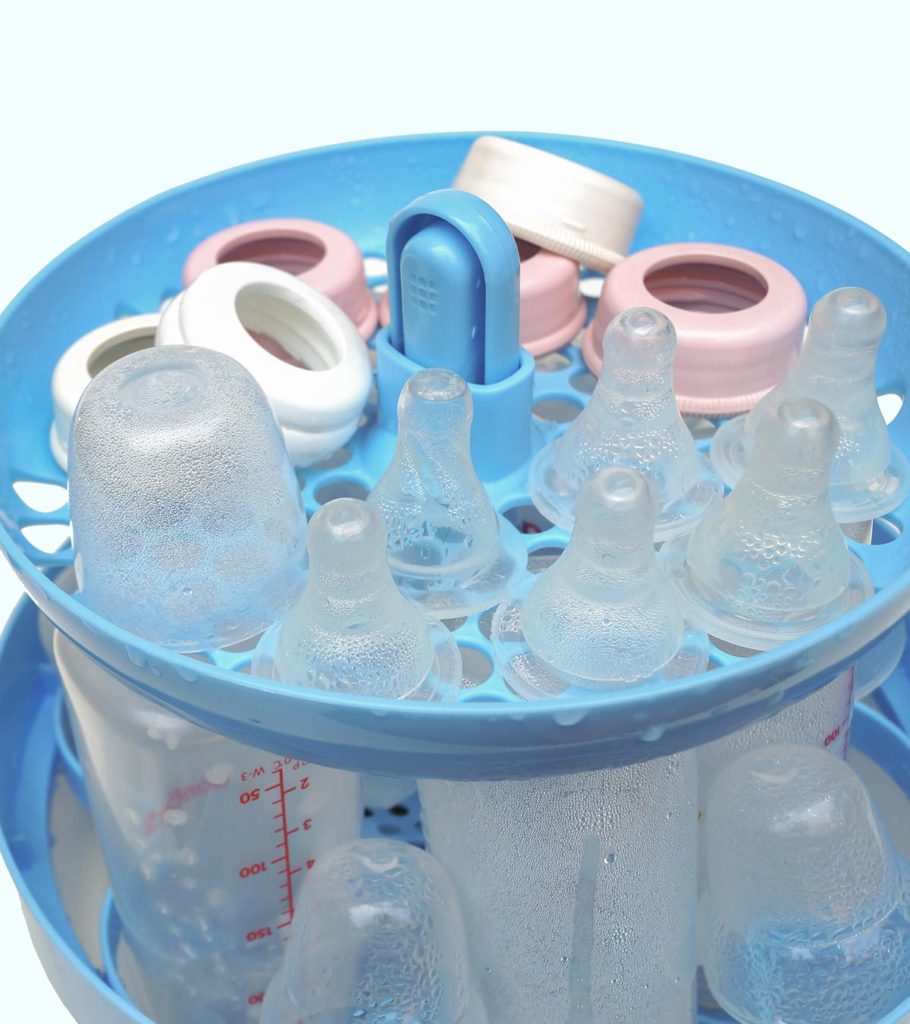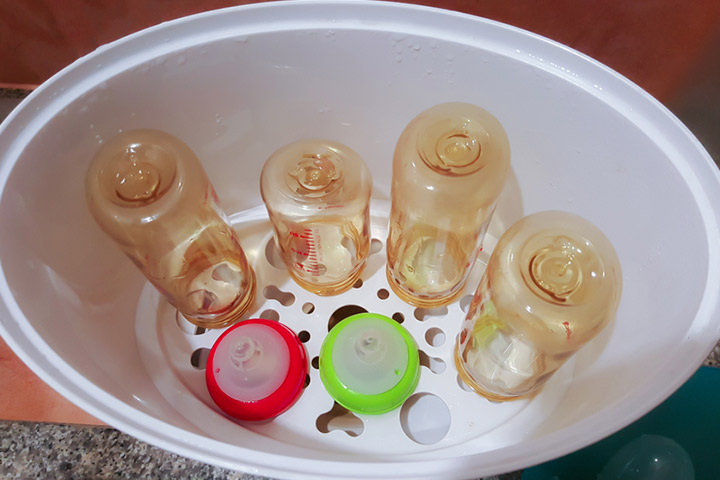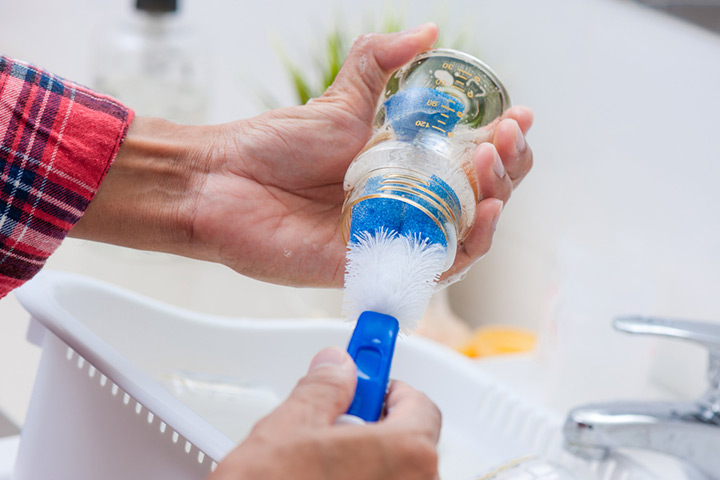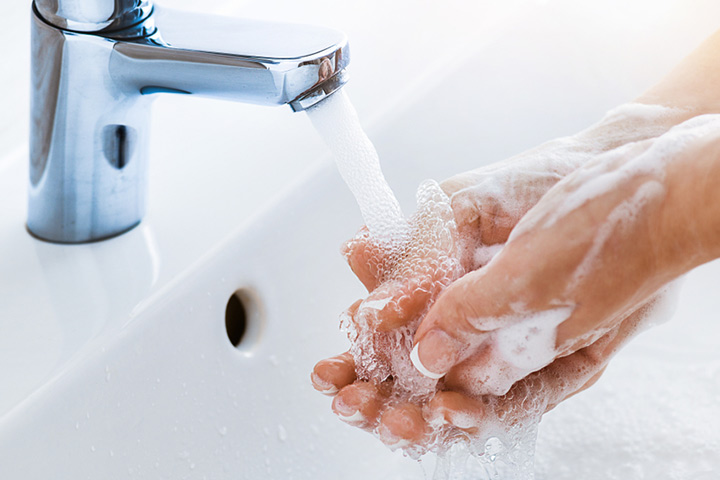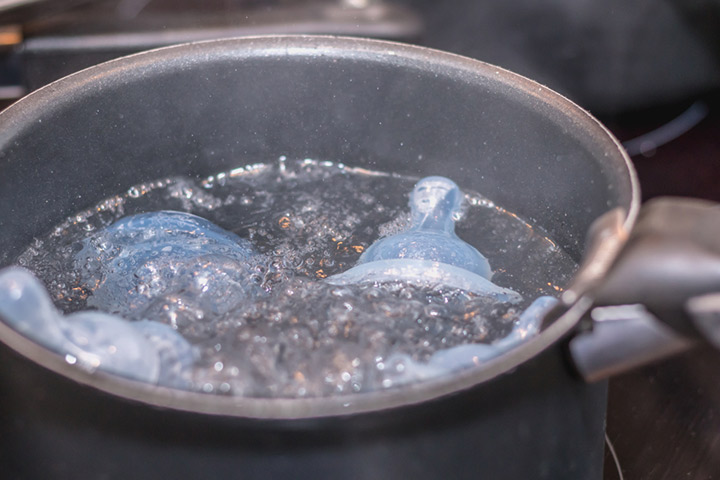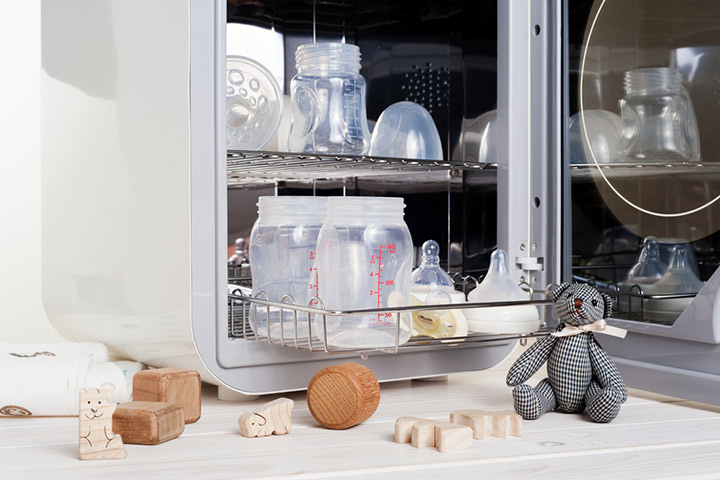You have brought your little bundle of joy home, and you are doing everything possible to keep them safe and healthy. This post on sterile baby bottles will help you learn more about this context. It is often said that breastfeeding is the best bonding time for a baby and a mother.
But bottle feeding is not bad either. It is a comfortable means of feeding as it gives the mother time to replenish her energy. But the most important thing that you should keep in mind while bottle feeding your baby is that the bottle should be sterile. Since babies have a weak immune system right after birth, their bodies are quite vulnerable to various diseases and infections.
Therefore, all possible sources of transmitting microorganisms should be taken care of. One such source is the feeding bottle. Read on to learn a few tips and tricks that you can use to sterilize your baby’s bottles.
Why To Sterilize Baby Bottles?
Several microorganisms like viruses, bacteria, and fungus can deposit in the bottle. They mix into the baby’s milk and enter her body, leading to vomiting, thrush, or diarrhea. According to the US Centers for Disease Control and Prevention, diarrheal diseases significantly contribute to child mortality, affecting approximately one in every nine children under five. Diarrhea has been estimated to adversely affect an average of about 2,195 children daily.
You need not have to sterilize them after every feed, as long as you are washing them with hot water and storing them in a sterile container (1). It is advisable to sterilize bottles once in a while. If your baby was recently down with flu or cold or has a weak immune system or is premature, you need to sterilize the bottles more frequently. Even though the babies develop better resistance against infections by the time they turn one, continue sterilization as long as she is on bottle feed.
Must-Do’s To Sterilize Baby Bottles
There are certain inevitable things to do for complete sterilization of your baby’s milk bottles.
1. Use Filtered Water
Regular tap water may have contaminants. It is basically hard water, which means that it can leave a residual layer of salts inside the bottle and other equipment. Therefore, use filtered water for sterilization. Even if you are using a steam sterilizer, you should use filtered water to ensure complete protection (2).
2. Clean The Bottles
Before sterilizing, clean the bottles, nipples, retaining rings and the scoop of the milk formula tin with warm soapy water.
You can clean the bottle and its parts using a bottle brush. While cleaning, rotate the brush to remove any dried milk or milk powder from the equipment.
Dishwasher, too, can be used to clean the feeding bottles. Place them on the top rack of the washer and run on a warm cycle (so that they do not melt).
Remove any traces of milk on all the bottle parts, including the lids. Turn the nipples inside out and wash.
Wash them just after feeding your baby to avoid the drying up of the leftover milk. After finishing the cleaning process, carefully rinse all soap. Clean your hands thoroughly before proceeding to sterilization.
3. Buy Food Grade Plastic Ware
If you are buying plastic feeding equipment for your baby, always go for food grade quality. Opt for the ones that are BPA-free or buy glass bottles (3). Do not forget to sterilize new bottles before use. Unless there are specific instructions, glass bottles can be sterilized the same way as the plastic ones.
Regularly check the bottles and nipples for splits, scratches, or cracks and replace the damaged feeding equipment. Bacteria tend to accumulate in such places and survive even after cleaning and sterilization.
4. Dry Separately
Use a clean and exclusive cloth to dry the sterilized bottles. Keep them on a separate shelf, and if possible, in an airtight container to avoid contamination due to dust. You can also seal them in a zip-up mesh.
5. Open Just Before Feeding
Remove the bottles from the sterilizer only before feed time. Keep the sterilizer covered with a lid until you need a bottle, to keep the feeding equipment free of germs.
6. Wash Your Hands
Wash your hands thoroughly or use proper sanitization methods before removing the bottles from the sterilizer. You may also use sterilized tongs to pull out accessories like teats and place them ready for use on the upturned lid of the sterilizer or on a clean surface.
Do not keep the sterilized bottles out for long. Put them in sterilizers with in storage facilities (if available) and remove just before use. If you could not use the sterilizers, then re-sterilize them if the bottle is taken out and left out for a long time.
The worldwide market size for baby bottle warmers and sterilizers reached USD 157.9 million in 2020. According to market research, this size is estimated to grow at a compound annual growth rate (CAGR) of 3.7% by 2028. This increase is attributed to these products’ ease of use and portability. Furthermore, the accompanying graph shows that the expansion in market size is driven by the rise in disposable income and the adoption of hypermarkets, supermarkets, drug and pharmacy stores, and online e-commerce platforms.
US baby bottle warmer and sterilizer market size, by distribution channel (2018-2028)
Source: Baby Bottle Warmer And Sterilizer Market Size, Share & Trends Analysis Report By Product (Baby Bottle Warmers, Baby Bottle Sterilizers), By Distribution Channel, By Region, And Segment Forecasts, 2021 – 2028; Grand View Research
The worldwide market size for baby bottle warmers and sterilizers reached USD 157.9 million in 2020. According to market research, this size is estimated to grow at a compound annual growth rate (CAGR) of 3.7% by 2028. This increase is attributed to these products’ ease of use and portability. Furthermore, the accompanying graph shows that the expansion in market size is driven by the rise in disposable income and the adoption of hypermarkets, supermarkets, drug and pharmacy stores, and online e-commerce platforms.
Different Methods Of Sterilizing Baby Bottles
There are various methods of sterilizing baby bottles, pacifiers, toddler cups, sippy cups, and even teethers. Here are a few most-used methods, with their set of advantages and disadvantages.
1. Boiling
Boiling water is the most common method of sterilization. This is simple but make sure that the bottles, nipples, and other parts are safe to boil.
- Take a big deep vessel with a lid, fill enough water to immerse the bottles and other parts fully, without any air bubbles. It is better to exclusively use the vessel for this purpose.
- You may have to weigh down plastic bottles with a heavy object, as they tend to float on the surface of the water due to their light weight.
- Parts of the bottle should not touch the bottom of the vessel, as direct heat may damage them. Glass bottles might crack, and plastic might melt.
- Boil them for around 10 minutes.
- Cover the vessel until you need to use the equipment. Repeat the process if you haven’t use the sterilized bottle for 24 hours.
Cover the vessel until you need to use the equipment. Repeat the process if you haven’t used the sterilized bottle for 24 hours.
The drawback with this method is that the bottle’s parts tend to get damaged faster than in other sterilization methods.
2. Cold Water Sterilizing
For cold water sterilization, you have to use a sterilizing solution or sterilization tablet diluted in cold water. These are effective against bacteria but can last only for 24 hours.
Various exclusively designed units are available in the market for this purpose or you can also use any plastic container with a lid. But, do not use the same plastic container twice as the sterilizing solution can affect the plastic and make it unusable. Follow these steps.
- Completely immerse the equipment in water. Ensure that there are no air bubbles in them.
- Follow manufacturer’s advice on the quantity of the solution or cold water to use.
- Leave them for half an hour.
- Remove nipples and bottles during feeding time.
- After taking the bottle and its equipment from the solution, shake well and rinse with boiled and cooled water.
- Discard the solution after 24 hours and clean the sterilizing container thoroughly using warm soapy water before preparing a fresh solution.
3. Steam Sterilizing
This method involves electric or microwave sterilizer, is an effortless and quick process. You must follow the manufacturer’s guidelines to sterilize through this method.
Electric Steam Sterilizing:
The process usually completes within 12 minutes, with additional cool down time.
- Fill the steamer with water and put the bottle and its parts in it.
- Close the lid and allow steam for a few minutes.
- Bottles remain sterile for about six hours if the cover is kept unopened.
Check if the equipment is allowed to steam, before placing inside the machine. Steam sterilizers can hold six bottles at a time and have separate racks for smaller items like nipples.
Place the feeding equipment and bottles with their open side facing downwards in the electric steam sterilizer to allow the steam to efficiently sterilize the feeding gear.
Microwave Sterilization:
This is another effective type of steam sterilizing, in which you put unsealed baby bottles (to avoid the rise of pressure in the bottle) in the microwave individually for about 90 seconds. It is a very quick method of sterilization. Before proceeding, make sure that your microwave is clean.
- Half fill each baby bottle with water.
- Place each bottle upright inside the microwave.
- Place nipples and rings in a microwave safe bowl filled with enough water to cover them.
- Microwave for approximately a minute and a half.
*Note: Wait before moving the bottles and nipples and be careful to avoid burning of your hand.
You can try microwave steaming with steamers specially designed for the purpose. It takes three to eight minutes for sterilization, with cooling time extra. The time taken may vary based on the model and wattage. The process is simple:
- Add water to the steam sterilizer.
- Toss the bottles in the microwave.
- A simple beep calls you to collect the sterilized stuff.
The benefit with electric sterilization or a microwave sterilization method is that the bottles remain sterile for about six hours if the cover is unopened. They do not leave any lingering taste or odor after the process.
4. Sterilizing With UV light
Ultraviolet light can purify water by killing bacteria, viruses, and mold. However, the technology is being used for baby products as well.
As it is still a new technology for baby bottles, there are no devices which can sterilize an entire feeding bottle. All you get is a UV device that can sterilize the nipples or pacifiers. Despite this short coming, the devices are portable and light weight. Sterilization can be done within three minutes.
Unsterilized baby bottles can harbor harmful pathogens that cause several infections and illnesses. Thus, sterilizing baby bottles after every feed is essential. Boiling, steaming, and cold water sterilization are common methods parents use to sterilize baby bottles. You can pick either method based on your convenience and careful contemplation of each method’s pros and cons. Cleaning your hands thoroughly before sterilization, using filtered water for cleaning, and drying bottles on a separate shelf are additional steps to ensure effective sterilization.
Key Pointers
- Microorganisms can infect a baby’s bottle and cause vomiting, thrush, or diarrhea.
- Sterilize bottles with filtered water and wash thoroughly with warm soapy water.
- Use BPA-free or glass bottles and check for breakages or splits after sterilization.
- Take bottles out just before feeding, and wash your hands thoroughly before handling them.
- Sterilize bottles more frequently if your child has been sick or is susceptible to illness.
Learn the essential steps to clean and sterilize baby bottles effectively. This easy-to-follow guide provides helpful tips for maintaining cleanliness and ensuring your baby’s health and safety.
